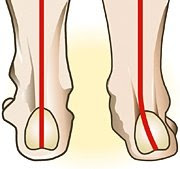The genetics of back pain – is back pain genetic or does a genetic trait cause back problems in families?
Many of our patients have heard that back pain is a result of foot problems – mainly the condition known as foot overpronation and asymmetrical gait (the way you walk). It seems that the scientific community is beginning to recognize this too (http://www.nytimes.com/2011/03/08/health/08really.html?_r=1).
It appears that having a family member with back pain increased your risk more than four times for having back problems and even disc issues. They also suggest that there may be a collagen protein that is genetically linked to sciatica.
One of the most common points of view in the medical community seems to be that we look at the micro and ignore the macro. In this case, the micro means the back and the macro means the entire body.
Years of treating back pain and studying other people’s work such as Brian Rothbart’s information on his theory on Bio Implosion has led to the conclusion that you have to look at the entire person. People inherit everything from other family members in their family tree. Back pain is one of those symptoms that is common enough, however, those with asymmetrical gait may never mention their legs are always tight, or that their neck is always stiff because it has always been that way and they consider it normal. The point I am making is asymmetry is inherited, and believe it or not, we not only facially look like our brothers, mothers, fathers, and sisters but we often inherit their body style and walk like them too. We only report what hurts, or what disables us, not what we perceive as normal.
 The evaluation process in the chiropractic office is a fact-finding mission, however, if the practitioner understands the concept of body style and its effect on chronic pain, the practitioner is way ahead and by looking at how someone stands and holds themselves, they can often predict what may hurt and where with a high degree of accuracy. This is quite different than trying to treat the back problem.
The evaluation process in the chiropractic office is a fact-finding mission, however, if the practitioner understands the concept of body style and its effect on chronic pain, the practitioner is way ahead and by looking at how someone stands and holds themselves, they can often predict what may hurt and where with a high degree of accuracy. This is quite different than trying to treat the back problem.
Incidentally, those same people with back problems also have knee, hip, neck, and even shoulder problems, all leading back to body style issues, rather than calling the problem a back problem. As a rule, the more accurately you diagnose the cause, the more likely you can eradicate the problem.
It is great to see that the medical community found out what is already in my upcoming book on chronic pain, but I wish they would look outside the box and see what is really happening in the body. Then, and only then will the cost of care for back problems and the suffering that accompanies it be reduced. The other side effect of beginning to look at the cause is fewer knees and hips that will go bad. I am sure that eventually, we will hear another study that miraculously states that gait problems cause knee and hip joints to wear out. Eventually, they may even realize that we are the sum of our parts. That would not be good for the future of the human bionic parts industry, because once you improve symmetry and body mechanics, fewer parts will wear out prematurely. That would be great news for the public.
